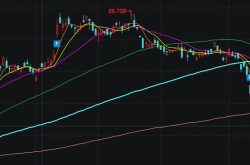Human Working History First! Securing a Trillion-Dollar Pay Package, Only Musk Can Forge a 'Deity'
![]() 11/14 2025
11/14 2025
![]() 377
377
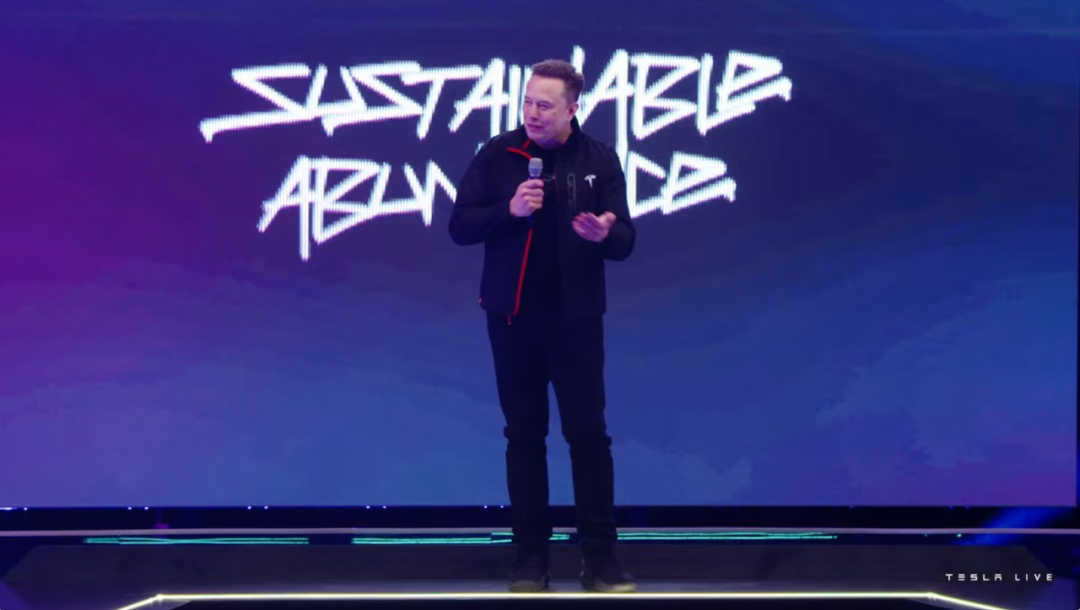
FSD Might Debut in China Within Six Months
Author: Wang Lei
Editor: Qin Zhangyong
The 'Celestial Dragon' of the working world has emerged.
Musk has just secured the largest compensation package in human history—a nearly $1 trillion incentive plan.
At Tesla's 'blockbuster' annual shareholder meeting, despite significant opposition from some shareholders regarding Musk's entitlement to this colossal compensation, Musk clinched the deal with an overwhelming 75% majority support.
This outcome was somewhat anticipated, as Musk had previously declared that if he didn't receive this salary, anyone else could step in as CEO of Tesla.
As soon as the proposal's passage was announced, the venue erupted in cheers, with Tesla shareholders chanting 'Elon! Elon!' in unison. Before Musk could utter a few words upon returning to the stage, he enthusiastically danced alongside a humanoid robot.

To be frank, Tesla's current situation is not promising, with declining sales and squeezed profits.
In this context, Tesla's ability to secure this incentive plan suggests that most shareholders are placing their bets on Musk, believing that this world's richest man can propel Tesla to the pinnacle of global success.
Of course, for Musk, it's time to roll up his sleeves. He subsequently unveiled Tesla's comprehensive plans across various business sectors to the assembled shareholders.
01
Earning This Money Won't Be a Walk in the Park
Let's first delve into how Musk secured this trillion-dollar pay package.
Similar to the previous astronomical compensation plan, this incentive is structured as restricted stock. Tesla's board of directors granted Musk up to 423.7 million restricted shares, accounting for roughly 12% of the company's adjusted total share capital, to be issued in 12 batches over a decade. The potential total value of the plan is approximately $1.03 trillion, equivalent to over RMB 7.1 trillion.
Even after deducting the stock cost at the time of the grant, the value still reaches $878 billion, approximately RMB 6.26 trillion.
Once fully realized, Musk's voting rights in the company could exceed 25%, granting him absolute control over Tesla at that juncture. This is also one of the reasons why Musk is so insistent on this astronomical compensation.

While the salary is enticing, the challenges are real.
This compensation plan will be unlocked in 12 stages over 10 years. For each stage target completed and KPI achieved, Musk will receive approximately 1/12th of the shares.
The targets are primarily categorized into three groups: market value, operational, and profit objectives.
First up is market value. The compensation plan mandates increasing Tesla's market value to $8.5 trillion (approximately RMB 61 trillion) by 2035, nearly six times Tesla's current market value of $1.4 trillion.
What does this entail? If this goal is realized, Tesla's market value could surpass all existing large publicly traded companies, more than doubling NVIDIA's current global market value leader of over $4 trillion.
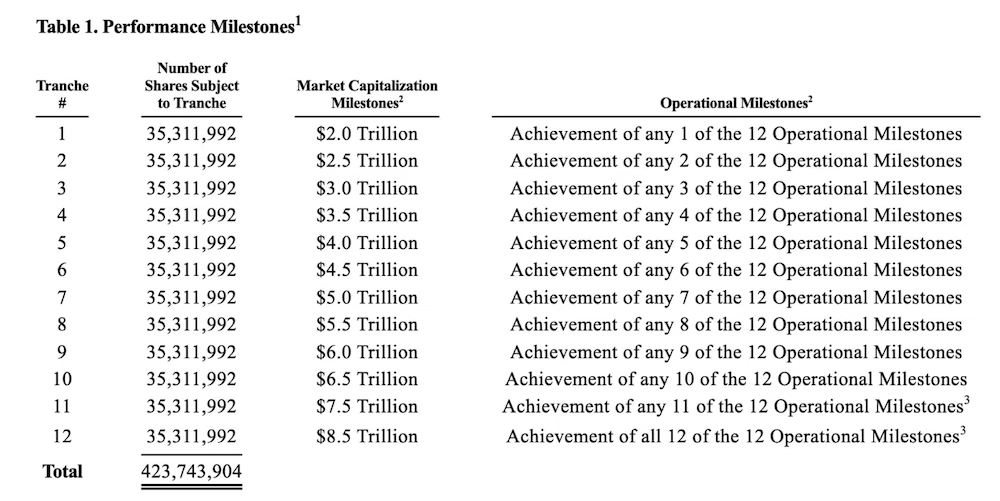
Of course, this is the ultimate goal for 2035. The initial target is a market value of $2 trillion. In the subsequent nine stages, each $500 billion increase in market value will unlock a portion, with the last two stages requiring a $1 trillion increase, culminating in an $8.5 trillion market value target.
Simple market value growth won't suffice to trigger the reward. Musk must also accomplish a series of operational KPIs concurrently for each stage of his compensation, spanning four core businesses: automotive, FSD (Full Self-Driving), Robotaxi, and humanoid robots (Optimus).
For instance, delivering 20 million Tesla vehicles, securing 10 million active FSD subscribers, delivering 1 million Optimus robots, and achieving 1 million Robotaxi commercial operations.
There are also stringent profit requirements, necessitating the attainment of a series of adjusted EBITDA (Earnings Before Interest, Taxes, Depreciation, and Amortization) benchmarks, with the highest needing to reach $400 billion (approximately RMB 2.85 trillion), nearly 24 times higher than the 2024 profit, and the lowest tier needing to reach $50 billion (approximately RMB 356.4 billion).
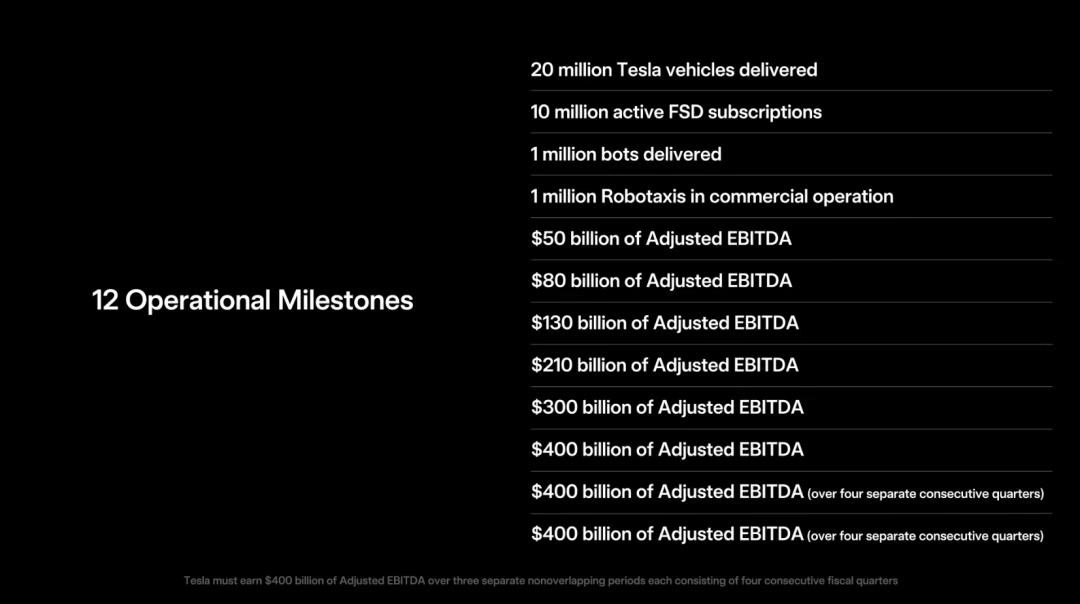
Based on Tesla's current performance, the largest target of 20 million Tesla vehicles is actually the most attainable. As of June this year, Tesla has already delivered a cumulative total of 8 million vehicles, leaving 12 million more for Tesla, which is not considered excessively challenging.
On the flip side, the requirement to secure 10 million active FSD subscribers means that for every two Tesla vehicles sold, one must purchase FSD and use it regularly. However, given the current penetration rate of FSD in Tesla vehicles, this is no small feat.
Additionally, robots and Robotaxis are still in the early stages of deployment. Although the requirements are not excessively high, who knows how the subsequent market will react?
Furthermore, the board of directors may be concerned that setting the requirements too high will cause Musk to leave midway, so they established a 'holding threshold' for this compensation plan—Musk must continue to serve as Tesla's CEO for the next seven and a half years; otherwise, the unvested equity will become invalid, effectively binding Musk and Tesla tightly together.
Moreover, even after all equity is unlocked, a five-year holding restriction must be observed to prevent short-term cashing out.
Finally, a 'fallback' plan was provided for Musk. If Tesla's market value only reaches $2 trillion in the next decade, the proposed compensation plan will pay Musk only $20 billion to acknowledge this 'achievement.'
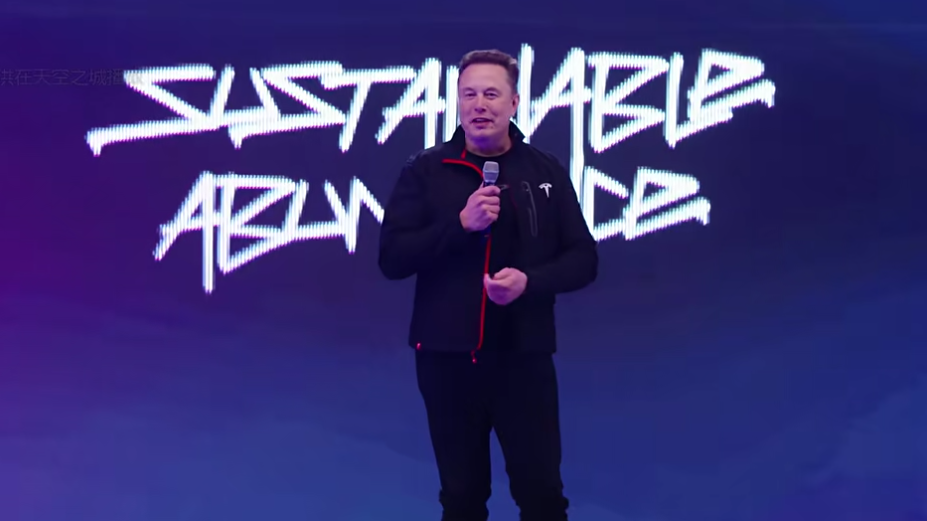
In case of natural disasters, wars, and other force majeure events, he can still receive a portion of the shares. However, once the targets are achieved, Musk will immediately gain voting rights.
And that 25% voting power may be what Musk truly desires—control over Tesla.
However, judging from the previous 10-year incentive plan, the requirements at that time were also exceptionally high for Tesla at that node. Yet, Musk truly led Tesla to complete the plan one by one and even achieved the targets ahead of schedule.
So, whether Musk can unlock these achievements remains uncertain.
02
Three Major Products Slated for Launch Next Year
After dancing, Musk seamlessly transitioned to serious matters—Tesla's future new car plans and AI product layouts, among 23 business priorities.
In Musk's words, 'Other companies' shareholder meetings are like lullabies, but ours is a blockbuster.'
One of the blockbusters is the Optimus robot standing next to Musk. At the outset, Musk reiterated, 'This will be the greatest product ever.'
He emphasized that this product is not just a high-tech toy. Optimus can truly eliminate poverty and even reshape the entire economic landscape. 'At some point, artificial intelligence and robotics can boost global economic growth by 10 times or even 100 times.'
He also envisioned a utopian future where, with Optimus, crime prevention would become more humane. 'It will always follow you and prevent you from committing crimes. I don't think we need to lock people up in prisons and the like. Thinking about all these possibilities is quite mind-boggling, but I think this is obviously the future.'

It is precisely because of the existence of Optimus that Musk announced the company's mission has been upgraded from 'accelerating the world's transition to sustainable energy' to 'accelerating the world towards sustainable abundance.' Musk believes that in the future, people will have unlimited access to goods, services, and healthcare while safeguarding humanity's survival environment on Earth.
After years of promises, Optimus finally has concrete actions. The robot production line will initiate 'the fastest production ramp-up among all large complex manufactured products in history,' starting with an annual production line of 1 million units at the Fremont factory, followed by a production line with an annual capacity of 10 million units in Texas.
Ultimately, the challenge is to produce 100 million robots annually. Once annual production reaches the million-scale, the cost per unit is expected to drop below $20,000, sufficient to compete directly with human labor.
In terms of product iteration, the current 2.5th generation Optimus humanoid robot is on display. Production of the third-generation humanoid robot will commence next year, followed by Optimus 4, which Musk hopes to start producing in 2027, and Optimus 5 in 2028.
Musk also stated, 'Perhaps at the next annual shareholder meeting, we will have Optimus answer some questions.' Next year, Musk will begin production of three major products: besides Optimus, there are the Tesla Semi and the Cybercab.
Musk stated that the new Semi will officially commence production in 2026 at the Nevada Gigafactory. Tesla has made numerous technological improvements to it, aiming to create a product that can truly replace diesel trucks for zero-carbon logistics. It boasts an 800 km range, 800 kW output power, 1.2 MW fast-charging capability, and consumes approximately 1 kWh per kilometer.

Regarding the self-driving taxi Robotaxi, the Cybercab will begin mass production in April next year at the Texas Gigafactory. Musk is quite optimistic about the production pace, expecting to achieve a production rate of one unit every 5-10 seconds, with annual production capacity rapidly increasing from 500,000 units to 2-5 million units.
The prerequisite for capacity expansion is the enhancement of FSD capabilities. Data shows that Tesla's assisted driving technology results in only one accident per 6.8 million miles driven globally, with safety ten times that of the average U.S. driver, nearly doubling from 2018. Additionally, FSD Supervised has been launched in six countries/regions, but FSD has not yet received regulatory approval in Europe.

Unexpectedly, Musk mentioned the progress of FSD in China, stating, 'We have already implemented some FSD functions in China and hope that the full version of FSD can enter China around February or March next year.' If it successfully enters China, it is not difficult to imagine that it will be a core driving force for Musk to achieve 10 million FSD subscriptions.
It is not hard to find that among the products scheduled for production next year, the all-new Roadster is not included. Just a while ago in an interview program, Musk said he would conduct 'the most epic demonstration' for the new Roadster by the end of this year.
However, now at the shareholder meeting, this timeline has been extended to April Fool's Day next year—April 1, 2026—let alone the production of the new car. According to Musk, production will only begin approximately 12-18 months later.
At this shareholder meeting, Musk also disclosed some details about the AI5 chip, saying candidly, 'My mind is full of chips, and I even dream about them.' Compared to AI4, AI5 will achieve a 9-fold increase in memory capacity, a 10-fold increase in computational efficiency, and a 50-fold increase in overall performance, with energy consumption only 1/3 of NVIDIA's Blackwell and costing less than 1/10.
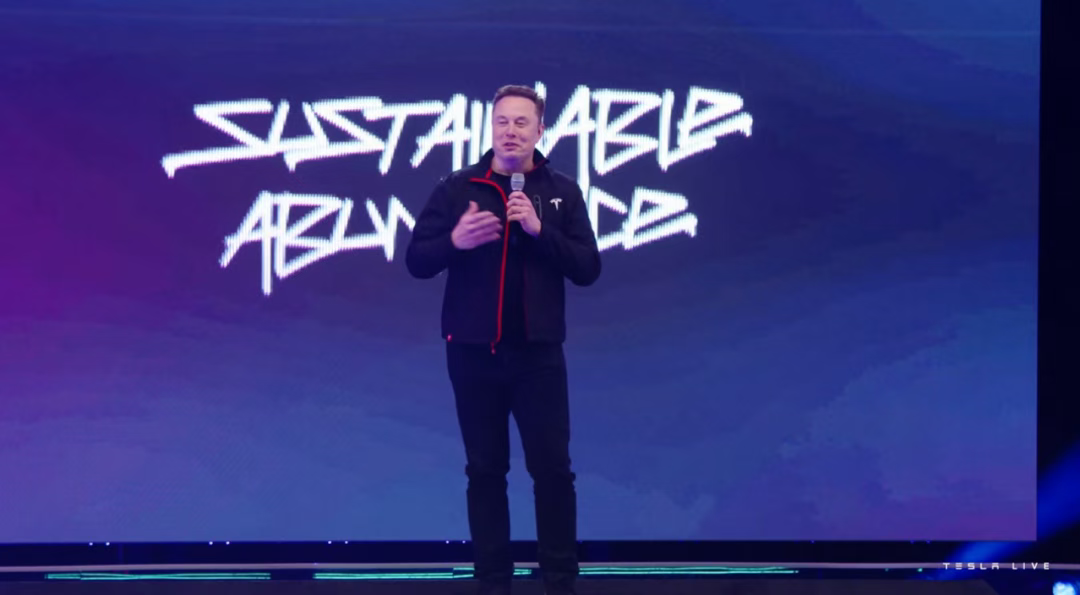
The AI6 chip is also in the planning stages. Musk hopes to transition to AI6 production within the same factory within one year of AI5 production commencing, with performance doubling that of AI5. To ensure a smooth transition, Musk revealed that a 'Terafab' mega-factory might be built.
There is still much work to be done next. The reason Musk can receive such a substantial incentive package is indeed justified. What is certain is that, regardless of whether the goals are achieved, we will witness an unprecedented future.

